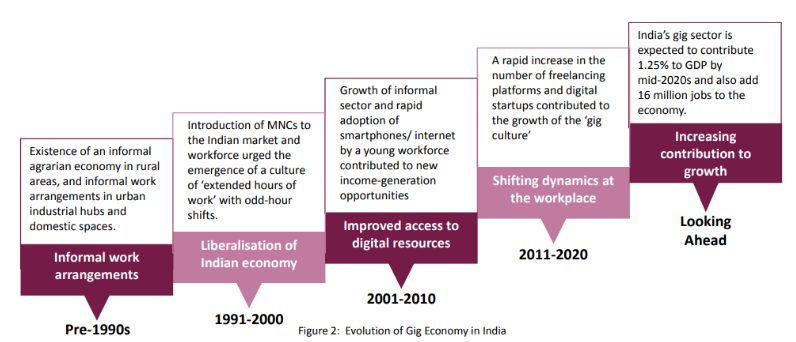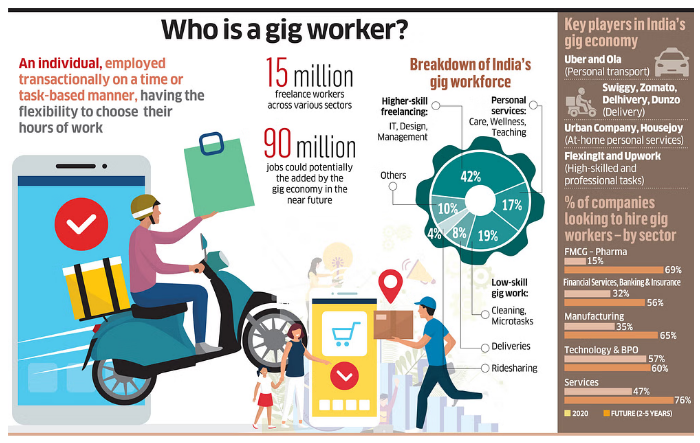Context: Recently, Rajasthan Platform Based Gig Workers (Registration and Welfare) Bill, 2023 was passed by Rajasthan Assembly.
| Probable Question:
Q. What are the challenges that the Gig Economy faces in India, and what steps can be taken to ensure its sustainable growth? |
About Gig Economy:
- A gig economy is a labor market that relies on independent contractors and freelancers rather than full-time permanent employees.
- Classification of Gig Economy:
- Platform-based: They use online apps or digital platforms to find and perform work, such as ride-hailing, food delivery, e-commerce, online freelancing, etc.
- Non-platform-based gig workers: They work outside the traditional employer-employee relationship, such as casual wage workers and own-account workers in sectors like construction, domestic work, agriculture, etc.
- Benefits of Gig Economy:
- For Workers: Gig economy can provide more flexibility, autonomy, income opportunities, skill development, and inclusion.
- For Employers: It can enable access to a large and diverse pool of talent, lower fixed costs, higher scalability, and better customer satisfaction.
- For Customers: It can offer more choice, convenience, quality, and affordability.
Enroll now for UPSC Online Course
Gig Economy in India:
- Prospect: According to a report by NITI Aayog, the platform-based gig economy in India has grown rapidly in recent years, driven by factors such as demographic dividend, urbanisation, digitalisation, and consumer demand.

- Platform Based: There are about 24 million platform-based gig workers in India as of 2020-21, accounting for about 6.5% of the non-agricultural workforce or 4% of the total workforce in India.
- The report also projects that the platform-based gig economy in India can create up to 56 million new jobs by 2029-30, adding up to 1.3% to India’s GDP in the long run.
- Non-Platform Based: According to Invest India, there are about 120 million non-platform-based gig workers in India as of 2019-20, accounting for about 32% of the non-agricultural workforce or 20% of the total workforce in India.
- The report suggests that the non-platform-based gig economy in India can create up to 34 million new jobs by 2029-30.
- Economic Contribution: In 2020, ASSOCHAM projected that India’s gig economy would rise at a compound annual growth rate of 17% to $455 billion by 2023.
- According to a report by Nasscom, the gig economy is expected to contribute around 1.25% to India’s GDP by 2025, with the potential to create 90 million jobs.
- Pillar of Strength: Gig economy has proven its resilience and potential in the wake of the Covid-19 pandemic, by continuing to unlock jobs in the millions and keeping communities connected.
Need of Gig Economy in India:
- Employment Opportunity: India as a developing country is faced with the challenge of providing employment opportunities to all. Gig economy has expanded the availability of jobs and improved labour force participation.
- Catering demand of low Skilled: At present, about 47 per cent of the gig work is in medium-skilled jobs, about 22 per cent in high skilled, and about 31 per cent in low-skilled jobs.
- Young demographic dividend: India has a large and growing population of young people who are well-educated and tech-savvy.
- Many millennials value flexibility and work-life balance and are drawn to the gig economy because of the opportunities it provides.
- Youth participation in the Gig economy has seen an 8-fold increase between 2019-2022.
- Female Labour Force: Female gig workers benefit from the income-generating potential, choice and the flexible work modalities of the gig economy.
- Women’s participation in the gig economy has increased from 18% to 36%.
- Catering to Retired Persons: Due to the flexibility that contract work offers, many people after retirement start working for themselves.
- Democratization of Jobs: The gig and platform sector has low-entry barriers and hence holds enormous potential for job creation in India.
- Technological Disruption: Tech advancements, particularly in AI, robotics, and data analytics, have eliminated workplace limitations. Tech integration in the gig economy can boost productivity and improve gig workers’ living standards.
- Last Mile Delivery: It has revolutionized the last-mile delivery industry, making it more accessible, affordable, and efficient.
- Remote Working: Telecommunications have made work more dynamic, allowing individuals to collaborate regardless of where they are geographically located.
- Start-Up Culture: Gig workers can be a cost-effective alternative to traditional employees, as they can be hired on a project-by-project basis, without the need to provide benefits or other forms of compensation.

Steps taken to Promote Gig Economy in India:
- Central Legislation: Code on Wages, 2019, a universal minimum wage and floor wage should be provided to all organized and unorganized sectors, including gig workers.
- Code on Social Security, 2020, the gig workers are provided with recognition as a new occupational category.
- Dedicated Social Security Fund to extend Social Security benefits to gig workers.
- State Government Initiatives: Karnataka government has announced for gig workers an accident and life insurance cover of Rs 4 lakh for which it will entirely bear the cost of the annual premium.
- Rajasthan Platform Based Gig Workers (Registration and Welfare) Bill, 2023
- Defines Gig Worker: Person who performs work or participates in a work arrangement and earns from such activities outside of the traditional employer-employee relationship and who works on a contract that results in a given rate of payment, based on terms and conditions laid down in such contract and includes all piece-rate work.
- Registration: It seek to register all gig workers and aggregators in the state, facilitate guarantee of social security to gig workers, and give them an opportunity to air any grievances.
- State government will maintain a database of the gig workers and generate a unique ID for every one of them.
- Rajasthan Platform Based Gig Workers Welfare Board: It will have two members each from gig workers and aggregators to be nominated by the state government besides two civil servants.
- Rajasthan Platform Based Gig Workers Social Security and Welfare Fund: For the benefit of registered gig workers. Welfare fees will be charged from aggregators.
- Penalties on Aggregators: State government may impose a fine which may extend up to Rs 5 lakh for the first contravention and up to Rs 50 lakh for subsequent contraventions.
Concern Associated with Gig Economy:
- Increase in Voluntary Unemployment: It has led to an increase in voluntary unemployment as some workers prefer the flexibility and autonomy of gig work over traditional employment.
- Disrupting Work-Life Balance: Flexibility of working gigs can actually disrupt the work-life balance, sleep patterns, and activities of daily life.
- It often means that workers have to make themselves available any time gigs come up, regardless of their other needs, and must always be on the hunt for the next gig.
- Job insecurity: Gig workers in India often lack job security, as they are typically engaged on a project or assignment basis, rather than as permanent employees.
- Income instability: Gig workers in India may experience fluctuations in income due to the irregular and unpredictable nature of gig work.
- Lack of formalization: Many gig workers in India operate in the informal sector, which can limit their ability to access credit, government support programs, and other resources.
- Lack of legal protection & social security: Gig workers are not covered under India’s labor laws and do not have legal protection in case of workplace harassment, discrimination, or unfair termination.
- Gig workers do not have access to social security benefits such as health insurance, retirement benefits, and paid leave.
- Unequal bargaining power: Gig workers in India may lack the bargaining power to negotiate fair compensation and working conditions, particularly when they are competing against a large pool of other workers on digital platforms.
- Training and upskilling: Many gig workers lack the necessary skills to perform their work effectively. Gig workers often have limited opportunities for upskilling and career advancement.
- Social stigma: Gig work is still viewed by some in India as a temporary or low-paying option, which can result in social stigma and lack of recognition for the work done by gig workers.
- Payments, Incentives, and Growth Models: Absence of a minimum wage guarantee makes workers susceptible to financial vagaries during crises/disasters
- Workplace Conditions & Interaction: Lack of appropriate forums that capture concerns of gig-workers and help platforms to understand the challenges and problem-solve
Enroll now for UPSC Online Classes
Way Forward:
- Health Benefits and Leaves: Gig economy platforms can provide health insurance benefits to their workers to ensure their well-being and safety.
- These include coverage for medical costs, hospitalization, preventive care services such as regular health check-ups and vaccinations, as well as paid leaves for workers.
- Skill Development for Informal Gig Employees: Platform-led upskilling initiatives are essential for enabling workers in the informal sector, such as driving or masonry, to take up jobs in the gig sector.
- Platform businesses can provide certifications, allowing workers to progress better in their careers.
- Adequate Protection: Although gig workers get minimum wages, they need certain legal protection, policies, and opportunities like other employees protected under labour laws.
- This can protect the rights of gig workers and help curb labour disputes.
- Addressing Gender Bias: Incentivise more women to take up the role, enabling platforms to expand markets and attract more women customers.
- Adopt gender-inclusive language and imagery to normalize participation of women platform gig-workers enabling platforms to expand markets and attract more women customers.
- NITI aayog recommended five-pronged RAISE approach to ensure realization of full access to social security for all gig and platform workers:
- Recognise the varied nature of platform work to design equitable schemes.
- Allow augmentation of social security through innovative financing mechanisms.
- Incorporate, while designing schemes, the specific interests of platforms, factoring the impact on job creation, platform businesses and workers.
- Support workers to subscribe to government schemes and welfare programmes through widespread awareness campaigns.
- Ensure benefits are readily accessible to workers.
- Incentivising ‘platformization’: To accelerate ‘platformisation’ i.e., give impetus for more platform businesses by starting a program called ‘Platform India’ along the lines of the government’s earlier Start Up India initiative.
Conclusion:
- The increasing demand for gig workers and the rise in participation of gig workers, especially the youth and women indicate that the gig economy in India is gaining popularity.
- According to a report by the International Labour Organization (ILO), India is the second-largest gig economy in the world, with around 56% of all gig workers in the Asia-Pacific region working in India.
- The gig economy is predicted to be a significant building block in achieving India’s aim to become a $5 trillion economy by 2025. This would help in bridging the income and unemployment gap.
- Greater collaboration between the government, employers, and workers’ organizations is needed to ensure that gig workers are able to enjoy their rights and access the benefits they are entitled to.
News Source: The Hindu
![]() 25 Jul 2023
25 Jul 2023

